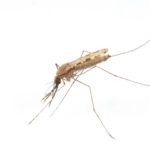Link to Pubmed [PMID] – 12605724
Malar. J. 2003 Feb; 2(): 1
Anopheles gambiae is the main vector of Plasmodium falciparum in Africa. The mosquito midgut constitutes a barrier that the parasite must cross if it is to develop and be transmitted. Despite the central role of the mosquito midgut in the host/parasite interaction, little is known about its protein composition. Characterisation of An. gambiae midgut proteins may identify the proteins that render An. gambiae receptive to the malaria parasite.We carried out two-dimensional gel electrophoresis of An. gambiae midgut proteins and compared protein profiles for midguts from males, sugar-fed females and females fed on human blood.Very few differences were detected between male and female mosquitoes for the approximately 375 silver-stained proteins. Male midguts contained ten proteins not detected in sugar-fed or blood-fed females, which are therefore probably involved in male-specific functions; conversely, female midguts contained twenty-three proteins absent from male midguts. Eight of these proteins were specific to sugar-fed females, and another ten, to blood-fed females.Mass spectrometry analysis of the proteins found only in blood-fed female midguts, together with data from the recent sequencing of the An. gambiae genome, should make it possible to determine the role of these proteins in blood digestion or parasite receptivity.


